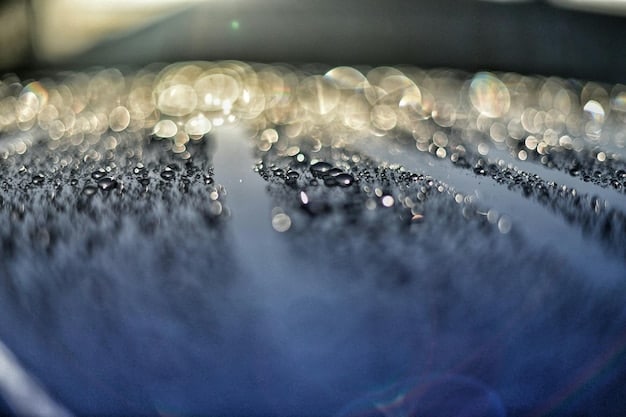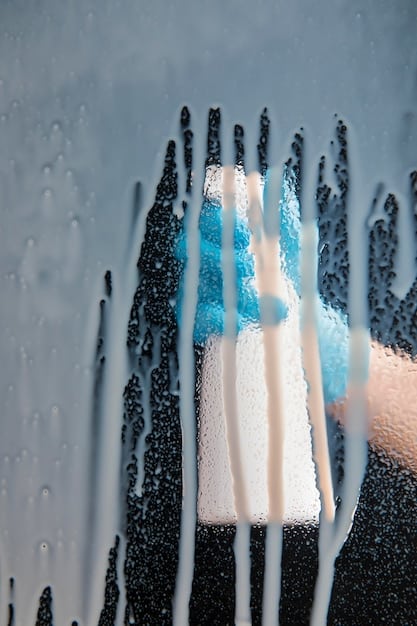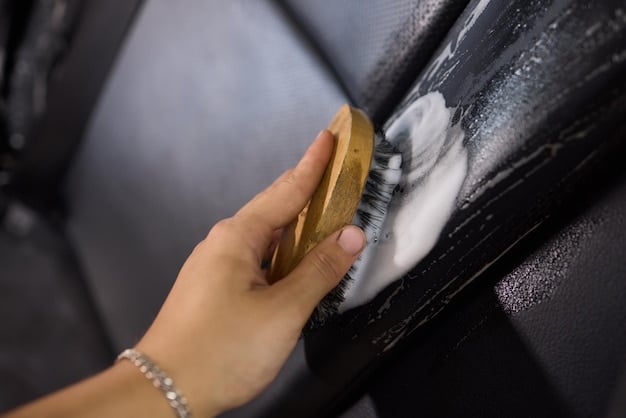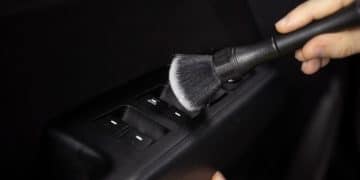Car Wash Secrets: Your Ultimate Guide to Pro-Level Cleaning

Car Wash Secrets: The Ultimate Guide to Washing and Waxing Your Car Like a Pro unveils expert techniques and essential steps to achieve a professional-quality clean and protective wax, ensuring your vehicle looks its best and maintains its value.
Want to keep your car looking showroom-ready without breaking the bank? Car Wash Secrets: The Ultimate Guide to Washing and Waxing Your Car Like a Pro reveals the insider tips and tricks to achieve a professional finish right in your driveway.
The Essential Tools and Products for a Professional Car Wash
Achieving a professional-quality car wash at home starts with having the right tools and products. Using the correct supplies not only makes the process easier but also ensures you’re not damaging your car’s paint.
The Right Buckets and Wash Mitts
The two-bucket method is crucial for preventing swirl marks. One bucket is for soapy water, and the other is for rinsing your wash mitt.
Choosing the Right Soap
Use a car-specific soap, not dish soap, which can strip away wax. Look for pH-balanced formulas that are gentle on your car’s paint.
- Microfiber Wash Mitts: These are gentle on your car’s paint and won’t scratch the surface.
- Two Buckets: One for washing, one for rinsing your mitt.
- Car Wash Soap: Specifically formulated to clean without damaging the paint.
Selecting the right tools and products sets the stage for an effective and safe car wash. Investing in quality supplies will pay off in the long run, preserving your car’s finish and keeping it looking its best.

Step-by-Step Guide to Washing Your Car Like a Pro
Now that you have the right tools, let’s dive into the step-by-step process of washing your car like a professional. Each step is designed to maximize cleanliness while minimizing the risk of scratches and swirls.
Pre-Rinsing Your Car
Begin by rinsing your car thoroughly with water to remove loose dirt and debris. This pre-rinse is crucial to prevent scratching the paint during the washing process.
Washing with the Two-Bucket Method
Dip your wash mitt into the soapy water, then gently wash a section of your car. Rinse the mitt in the clean water bucket before re-dipping into the soapy water.
- Rinse Thoroughly: Ensure all soap residue is removed from your car’s surface.
- Dry with Microfiber Towels: Use clean, soft microfiber towels to prevent water spots.
- Work in Sections: Focus on one area at a time for thorough cleaning.
Following these steps ensures a clean, scratch-free car wash. Taking your time and being gentle will yield the best results, leaving your car looking spotless and well-maintained.
The Art of Drying: Preventing Water Spots and Streaks
Drying your car properly is just as important as washing it. If done incorrectly, water spots and streaks can detract from your efforts.
Using Microfiber Drying Towels
Microfiber towels are your best bet for drying your car without scratching. They are super absorbent and gentle on the paint.
The Blotting Technique
Instead of wiping, try blotting the water off your car’s surface. This reduces the friction that can cause swirl marks.
- Waffle Weave Towels: These are particularly effective at absorbing water.
- Air Blowers: Consider using an air blower to remove water from hard-to-reach areas.
- Drying Aids: Products that help water sheet off the car can also reduce spots.
Mastering the art of drying ensures your car looks its best after washing. By using the right tools and techniques, you can achieve a spot-free, streak-free finish every time.
Waxing 101: Choosing the Right Wax for Your Car
Waxing is essential for protecting your car’s paint and giving it a deep, glossy shine. But with so many waxes on the market, choosing the right one can be confusing.
Types of Car Wax
There are several types of car wax, each with its own benefits and drawbacks. Understanding these differences is key to making the right choice.
Application Methods
Whether you’re using a paste, liquid, or spray wax, proper application is crucial. Follow the manufacturer’s instructions carefully.
- Carnauba Wax: Known for its deep shine and protective qualities.
- Synthetic Wax: Offers excellent durability and protection.
- Spray Wax: Quick and easy to apply, ideal for maintaining an existing wax coat.
Choosing the right wax and applying it correctly can significantly enhance your car’s appearance and protect its paint. Take the time to research and select a wax that meets your specific needs and preferences.

Waxing Techniques: Achieving a Flawless Finish
Applying wax correctly is crucial for achieving a flawless finish. Proper technique ensures even coverage and maximum shine.
Preparing Your Car’s Surface
Before waxing, make sure your car’s surface is clean and dry. Any dirt or debris can scratch the paint during the waxing process.
Applying Wax Evenly
Use a foam applicator pad to apply wax in thin, even layers. Overlapping your strokes ensures complete coverage.
- Circular Motions: Apply wax in small, circular motions for even coverage.
- Thin Coats: Avoid applying too much wax at once. Thin coats are easier to buff off.
- Buffing: Use a clean microfiber towel to buff off the wax, revealing the shine.
Mastering these waxing techniques will help you achieve a showroom-worthy finish. Taking your time and paying attention to detail will result in a smooth, glossy surface that enhances your car’s appearance.
Maintaining Your Car’s Shine: Regular Washing and Waxing
Maintaining your car’s shine requires regular washing and waxing. Consistent care will keep your car looking its best and protect its paint from the elements.
How Often to Wash and Wax
The frequency of washing and waxing depends on several factors, including your climate and how often you drive.
Touch-Up Tips
Between full washes and waxes, there are several touch-up tips you can use to maintain your car’s appearance.
- Regular Washing: Wash your car every 1-2 weeks to remove dirt and grime.
- Wax Every 3-4 Months: Apply a fresh coat of wax to protect the paint and enhance the shine.
- Quick Detailing Sprays: Use these to remove light dust and fingerprints between washes.
Regular washing and waxing are essential for maintaining your car’s appearance and protecting its paint. By following these tips, you can keep your car looking its best for years to come.
| Key Aspect | Brief Description |
|---|---|
| 🧼 Two-Bucket Method | Use separate buckets for washing and rinsing to prevent scratches. |
| 🧴 Car-Specific Soap | Avoid dish soap and use pH-balanced car wash soap. |
| ✨ Microfiber Towels | Use microfiber cloths for both washing and drying. |
| 🛡️ Waxing | Wax every 3-4 months to protect the car’s paint and enhance shine. |
Frequently Asked Questions
▼
The two-bucket method involves using one bucket for soapy water and another for rinsing your wash mitt, helping to prevent scratches.
▼
It’s recommended to wash your car every 1-2 weeks to remove dirt and maintain its appearance.
▼
Carnauba wax is great for shine, while synthetic wax offers better durability and protection.
▼
No, dish soap can strip away wax and damage your car’s paint. Use car-specific soap instead.
▼
Dry your car immediately after washing using microfiber towels or an air blower for a spot-free finish.
Conclusion
By following these car wash secrets, you can achieve a professional-quality clean and wax, keeping your car looking its best and protecting it from the elements. Regular maintenance and proper techniques are key to a showroom-ready finish.





